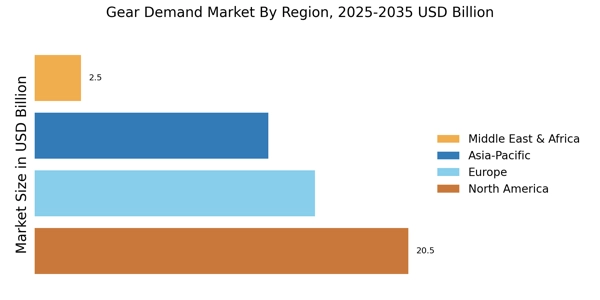Growing Automotive Sector
The Gear Demand Market is closely tied to the growth of the automotive sector, which continues to evolve with advancements in technology and consumer preferences. The shift towards electric vehicles (EVs) and hybrid models is creating new opportunities for gear manufacturers. These vehicles require specialized gear systems to optimize performance and efficiency. Recent data indicates that the automotive industry is projected to grow at a steady pace, with electric vehicle sales expected to increase significantly in the coming years. This growth is likely to drive demand for innovative gear solutions, positioning the Gear Demand Market as a key player in the automotive transformation.
Technological Advancements
The Gear Demand Market is experiencing a notable surge due to rapid technological advancements. Innovations in materials and manufacturing processes have led to the production of lighter, stronger, and more durable gears. For instance, the integration of computer-aided design (CAD) and 3D printing technologies has streamlined production, reducing lead times and costs. As industries increasingly adopt automation and robotics, the demand for precision gears is likely to rise. According to recent data, the gear manufacturing sector is projected to grow at a compound annual growth rate of approximately 5.2% over the next five years. This growth is indicative of the Gear Demand Market's responsiveness to technological changes, which enhances efficiency and performance across various applications.
Increased Industrialization
The Gear Demand Market is significantly influenced by the ongoing trend of increased industrialization across various sectors. As countries continue to develop their manufacturing capabilities, the need for reliable and efficient gear systems becomes paramount. Industries such as automotive, aerospace, and machinery are expanding, driving the demand for high-quality gears. Recent statistics indicate that the manufacturing sector's contribution to GDP is on the rise, suggesting a robust economic environment that supports gear production. This industrial growth is likely to propel the Gear Demand Market forward, as companies seek to enhance productivity and operational efficiency through advanced gear solutions.
Rising Demand in Renewable Energy
The Gear Demand Market is witnessing a shift as the renewable energy sector expands. Wind and solar energy systems require specialized gears for optimal performance and efficiency. The increasing investment in renewable energy infrastructure is driving the demand for gears that can withstand harsh environmental conditions while maintaining reliability. Recent reports indicate that the renewable energy market is expected to grow significantly, with wind energy alone projected to account for a substantial share of new installations. This trend suggests that the Gear Demand Market will benefit from the growing emphasis on sustainable energy solutions, as manufacturers adapt their offerings to meet the specific needs of this sector.
Focus on Customization and Flexibility
The Gear Demand Market is increasingly characterized by a focus on customization and flexibility in gear production. As industries seek tailored solutions to meet specific operational requirements, manufacturers are adapting their processes to offer bespoke gear systems. This trend is particularly evident in sectors such as aerospace and robotics, where precision and adaptability are crucial. Recent surveys suggest that a significant percentage of companies are prioritizing customized gear solutions to enhance their competitive edge. This shift towards personalization indicates a dynamic landscape within the Gear Demand Market, where responsiveness to client needs is becoming a critical driver of growth.


















Leave a Comment